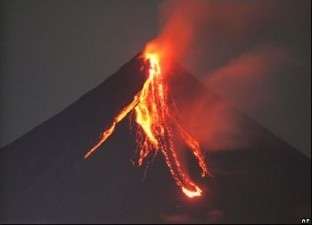
Volcanoes are formed when the hot magma reaches the Earth's surface and erupts.The word volcano originally comes from the name of the Roman god of fire, Vulcan.
Volcanoes can be active (regular activity), dormant (recent historical activity but now quiet) or extinct (no activity in historical times and unlikely to erupt again).
About 30 kilometers beneath your feet present is the mantle of the Earth. It has super hot rock in fluid state. It is called magma and extends down to the core.
Magma is lighter than the rock surrounding it. This is why it rises up through cracks and weak points in the Earth's crust. When it erupts out of the surface, it brings lava, rock, ash and various volcanic gases along with.
The molten rock when under the Earth is called magma while when it has erupted out, it is called lava.
Volcanoes are usually located where tectonic plates meet. This is especially true for the Pacific Ring of Fire, an area around the Pacific Ocean where over 75% of the volcanoes on Earth are found.
While most volcanoes form near tectonic boundaries, they can also form in areas that contain abnormally hot rock inside the Earth. Known as mantle plumes, these hotspots are found at a number of locations around the globe with the most notable being in Hawaii.
Some famous volcanic eruptions of modern times include Mount Krakatoa in 1883, Novarupta in 1912, Mount St Helens in 1980 and Mt Pinatubo in 1991.
While we certainly have some big volcanoes here on Earth, the biggest known volcano in our solar system is actually on Mars. Its name is Olympus Mons and it measures a whooping 600km (373 miles) wide and 21km (13 miles) high.
The object with the most volcanic activity in our solar system is Io, one of Jupiter's moons. Covered in volcanoes, its surface is constantly changing to the large amount of volcanic activity.
There are also volcanoes found on the ocean floor and even under icecaps, such as those found in Iceland.
Common volcanic gases include water vapor, carbon dioxide, sulfur dioxide, hydrogen chloride, hydrogen fluoride and hydrogen sulfide.
Geologists measure volcano eruptions using the Volcano Explosivity Index, which measures the amount of material released. A 'small' eruption like Mount St. Helens was a 5 out of 8, releasing a cubic kilometer of material. The largest explosion was on record was Toba, thought to have erupted 73,000 years ago. It released more than 1,000 cubic kilometers of material, and created a caldera 100 km long and 30 kilometers wide. The explosion plunged the world into a world wide ice age. Toba was considered an 8 on the VEI.
Volcanic eruptions can send ash high into the air, over 30km (17 miles) above the Earth's surface.
Large volcanic eruptions can reflect radiation from the Sun and drop average temperatures on Earth by around half a degree.


 Volcanoes are formed when the hot magma reaches the Earth's surface and erupts.The word volcano originally comes from the name of the Roman god of fire, Vulcan.
Volcanoes are formed when the hot magma reaches the Earth's surface and erupts.The word volcano originally comes from the name of the Roman god of fire, Vulcan.



